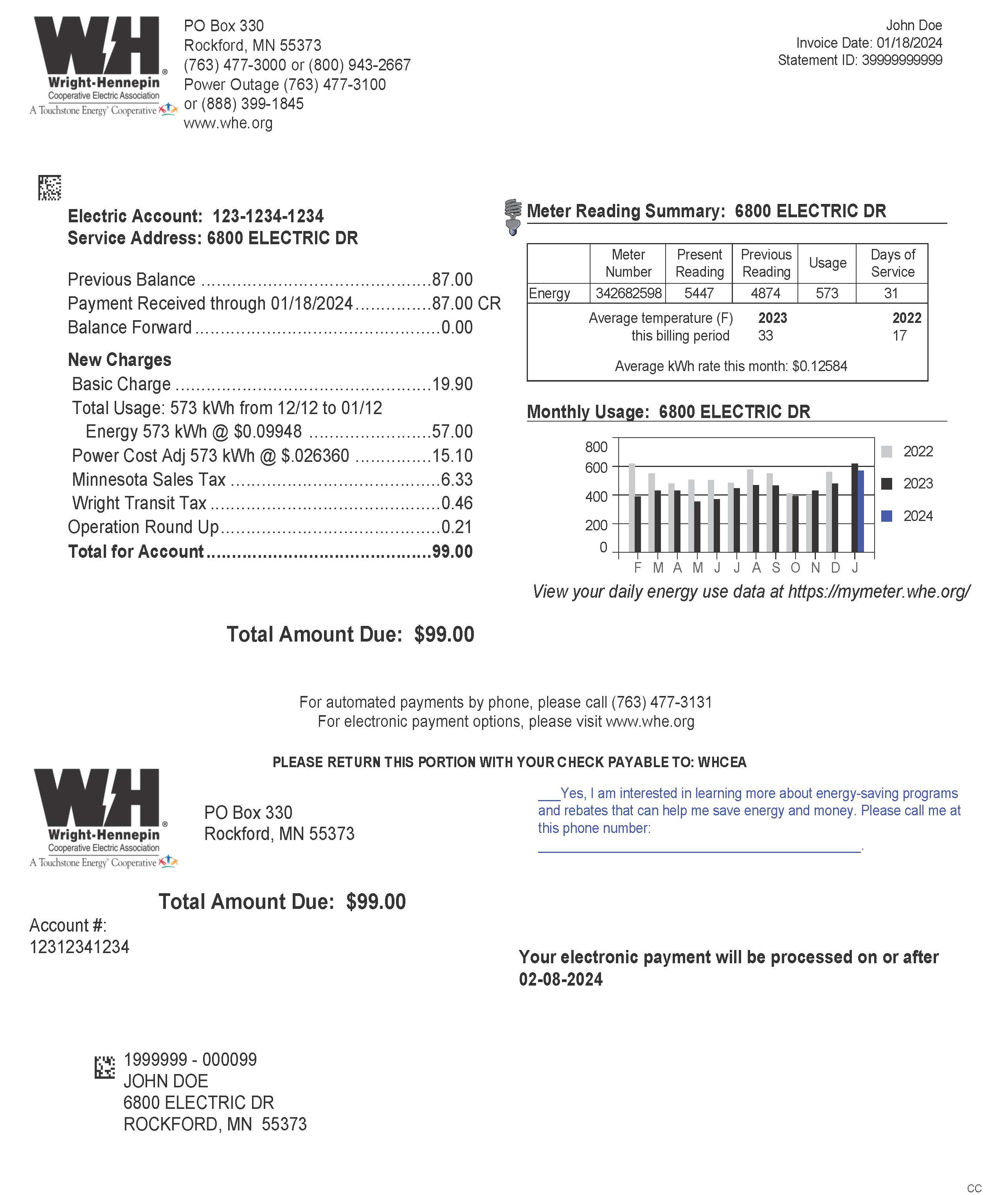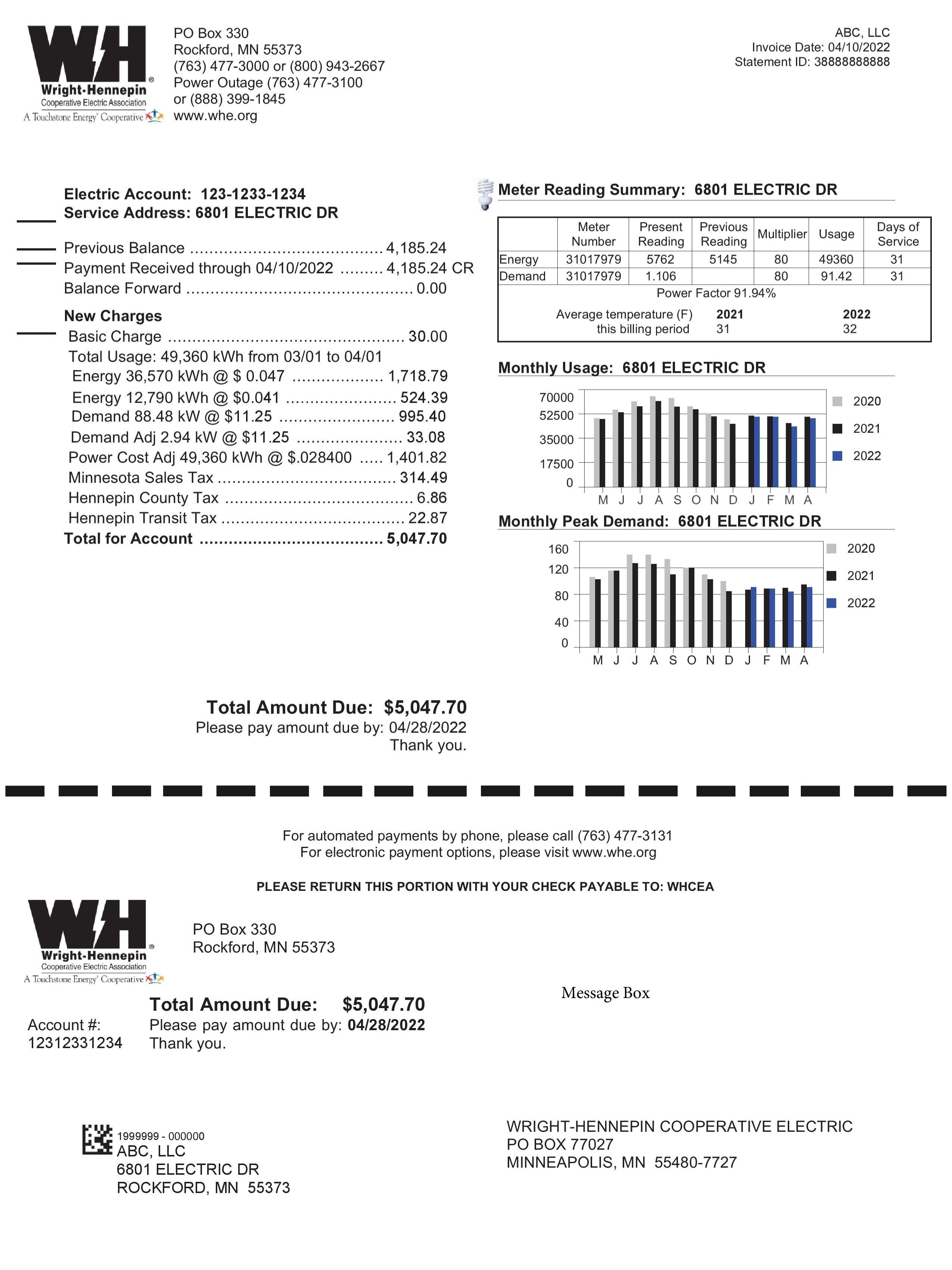Contact Information
This section details WH's contact information

Wright-Hennepin has designed your electric bill so that it is easy to read and understand.
Your electric bill contains important information. Look at the graphic below for an explanation of the different areas of your electric bill. Examples of both a residential and commercial bill are shown. If you have further questions that haven’t been answered by this page, please contact us.
* The example bills are for illustrative purposes only, and therefore may not reflect certain charges on your electric billing. In these instances, please contact us at (763) 477-3000.

This section details WH's contact information
This corner of your bill shows your invoice date, and the statement ID.
Your account number identifies you in our billing system. Have this number handy when you contact us with billing questions. You will also need your account number to sign up for some online billing services.
This section details your previous billing period’s balance and any payments received through the specified date. If there is a balance carried over, that also appears in this section.
This section breaks down the charges on your current bill, including electric use, taxes, franchise fees, and other charges. Franchise fees are collected by some local governments to pay for specific programs or projects within that city’s jurisdiction. WH is required to collect the fee on their behalf and does not keep it.
This is the tear-off stub that you send in with your payment.
This table contains your current meter reading data, including the average temperature for this billing period, compared to last year.
This graph shows monthly electric use for the past 24 months. For daily energy use, check out WH’s MyMeter tool.
The date your payment is due and the amount are shown here.
This message area keeps you informed of special offers and other important information related to your service.
If your account is on autopay (automatic withdrawal of payment from a checking, savings, or credit card account) a message stating the date of withdrawal will be listed here. If your account is NOT on autopay, program, you will see WH’s payment mailing address.
Here you will find the responsible name(s) on the account and the mailing address. This may be different than the actual service address.

This section details WH's contact information
This corner of your bill shows your invoice date, and the statement ID.
Your account number identifies you in our billing system. Have this number handy when you contact us with billing questions. You will also need your account number to sign up for some online billing services. If you receive service at more than one location (or have multiple electric services), you will have a different account number for each location (or service).
This section shows your previous bill's balance and any payments received up to the current bill's statement date. If there is a balance carried over, that also appears in this section.
Demand Adjustment - WH’s established guidelines include that the customer/member shall maintain power factor as near to unity as practicable. Should WH’s measurements indicate that the average power factor is less than 95 percent for the billing period, a demand adjustment will be applied.
Power Cost Adjustment (PCA) – WH uses the Power Cost Adjustment to adjust electricity prices according to changes in our wholesale power costs as they fluctuate throughout the year.
State and local taxes applicable to your bill are also shown here.
This section shows information about your meter and usage. It includes the meter serial number (i.e. 88888888), present and previous meter readings, total usage, days of service and the meter multiplier. The multiplier number is determined by the metering equipment installed for this account and is used to determine the actual amount of usage. The days of service shows the number of days in this billing cycle. The electricity the consumer/member uses is measured as follows:
This area also includes monthly power factor information (if applicable).
These charts compare monthly energy usage and peak demand over a 24-month period.
This is the amount that must be paid by the due date to avoid any late charges. A late charge will be applied to the next monthly bill if payment is not received by the date specified on the bill.
This is the tear-off stub that you send in with your payment.
This message area keeps you informed of special offers and other important information related to your service.
Here you will find the responsible name(s) on the account and the mailing address. This may be different than the actual service address.
If your account is on the Electronic Funds Transfer (EFT) program (automatic withdrawal of payment from a checking, savings, or credit card account) a message will appear monthly, stating the date of withdrawal. If your account is NOT on the EFT program, you will see WH’s payment mailing address.